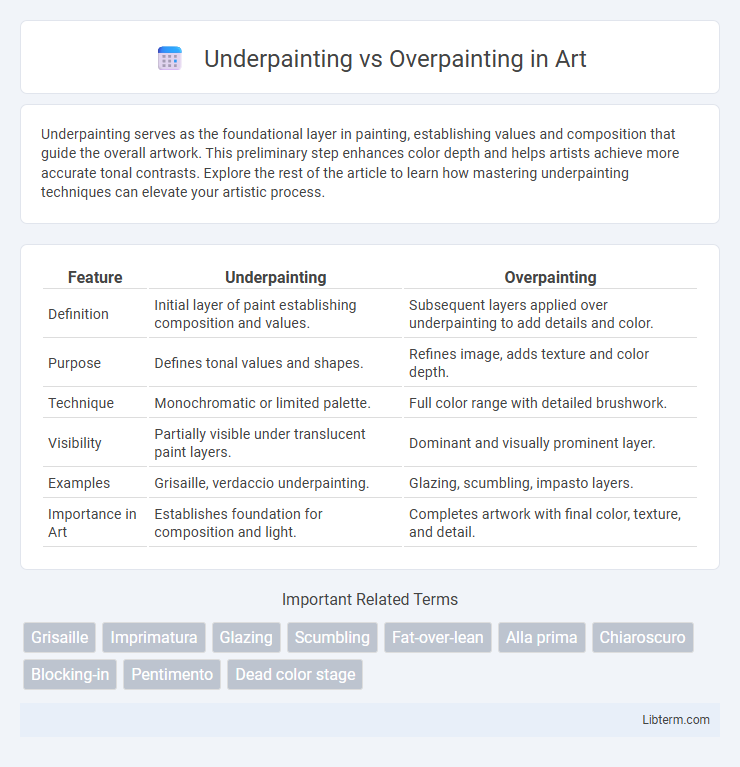Underpainting serves as the foundational layer in painting, establishing values and composition that guide the overall artwork. This preliminary step enhances color depth and helps artists achieve more accurate tonal contrasts. Explore the rest of the article to learn how mastering underpainting techniques can elevate your artistic process.
Table of Comparison
| Feature | Underpainting | Overpainting |
|---|---|---|
| Definition | Initial layer of paint establishing composition and values. | Subsequent layers applied over underpainting to add details and color. |
| Purpose | Defines tonal values and shapes. | Refines image, adds texture and color depth. |
| Technique | Monochromatic or limited palette. | Full color range with detailed brushwork. |
| Visibility | Partially visible under translucent paint layers. | Dominant and visually prominent layer. |
| Examples | Grisaille, verdaccio underpainting. | Glazing, scumbling, impasto layers. |
| Importance in Art | Establishes foundation for composition and light. | Completes artwork with final color, texture, and detail. |
Understanding Underpainting: Definition and Techniques
Underpainting is a foundational painting technique where an initial monochromatic layer establishes the composition, values, and tonal contrasts before applying final colors. Common methods include grisaille, using shades of gray to build depth, and verdaccio, employing greenish hues to enhance skin tones and shadow areas. This approach enhances color vibrancy and spatial depth, providing a structured base that guides subsequent brushwork and color application.
Overpainting Explained: Purpose and Methods
Overpainting involves applying a layer of paint over an existing dried or semi-dried underpainting to enhance details, enrich color depth, and correct imperfections. Common methods include glazing, scumbling, and layering to create texture and luminosity, allowing artists to refine the composition and achieve desired visual effects. This technique effectively builds complexity and dimensionality, playing a crucial role in traditional and contemporary painting processes.
Historical Context: Evolution of Painting Layers
Underpainting, originating in the Renaissance, served as a tonal foundation that artists like Leonardo da Vinci used to map out composition and light before applying color. Overpainting evolved as painters layered glazes and opaque colors atop this base to build depth and realism, a technique perfected during the Baroque period by masters such as Rembrandt. The transition from underpainting to overpainting reflects a historical shift in artistic methods aimed at enhancing texture, color vibrancy, and three-dimensionality in oil paintings.
Key Differences Between Underpainting and Overpainting
Underpainting involves creating a monochromatic base layer to establish composition and tonal values, serving as a foundation for subsequent layers. Overpainting refers to applying layers of color and detail on top of the underpainting to develop the final image with depth and texture. The key differences lie in their purpose, with underpainting focusing on structural groundwork and overpainting emphasizing refinement and color enhancement.
Materials Best Suited for Underpainting
Underpainting materials typically include fast-drying, matte mediums such as acrylics and gouache, which provide a stable base for subsequent layers. Artists often prefer preparations like burnt sienna or raw umber to create tonal values and enhance depth before applying oil or acrylic overpainting. These materials allow for better adhesion and control over the final composition, ensuring durability and vibrancy in the finished artwork.
Tools and Techniques Used in Overpainting
Overpainting involves applying layers of paint over a dried base layer, commonly using fine brushes, palette knives, and glazing medium to build texture and depth. Artists use glazing techniques with translucent paints to enhance color vibrancy and achieve subtle tonal variations. Tools like soft brushes enable delicate blending, while palette knives help create impasto effects, enriching the artwork's dimensionality.
Advantages and Challenges of Underpainting
Underpainting provides a strong tonal foundation that enhances depth and color accuracy, allowing for better control over light and shadow in the final artwork. It accelerates the painting process by establishing values early, reducing mistakes and improving overall composition cohesion. However, challenges include the risk of the underlayer showing through undesirably and difficulty in correcting errors once subsequent layers are applied.
Benefits and Drawbacks of Overpainting
Overpainting enhances depth and detail by allowing artists to correct mistakes and refine textures, leading to richer, more polished artwork. However, excessive overpainting can obscure initial layers, potentially diminishing transparency and affecting the painting's luminosity. Careful balance is crucial to maintain the vibrancy and integrity of the underpainting while achieving desired visual effects.
When to Choose Underpainting vs Overpainting
Choose underpainting when establishing the foundation of a painting, as it helps define tonal values and composition before applying final colors. Overpainting is ideal for refining details and adding depth on top of a dry base layer, allowing for greater control over texture and color blending. Selecting underpainting or overpainting depends on the desired workflow and whether the artist prioritizes structural groundwork or detailed surface enhancement.
Expert Tips for Combining Both Techniques in Artwork
Expert tips for combining underpainting and overpainting emphasize using underpainting to establish tonal values and composition with monochromatic layers, allowing for a solid foundation of light and shadow. Overpainting involves applying subsequent color layers that bring vibrancy and detail, enhancing depth while respecting the tonal groundwork set by the underpainting. Master artists recommend selecting compatible mediums--such as acrylics for underpainting and oils for overpainting--to optimize drying times and layering effects.
Underpainting Infographic

 libterm.com
libterm.com